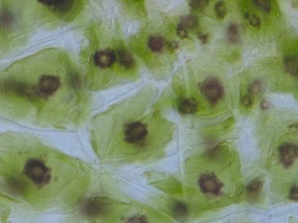CO2 Limitation in Photosynthesis
-
•Do some aquaporins function as CO2 pores in the leaf? Some of my highest impact and ongoing research has been at the leaf level, measuring the in vivo conductance of CO2 inside leaves (Flexas et al. 2006, Uehlein et al. 2008, Heckwolf et al. 2011). These papers utilized mutants from Prof. Ralf Kaldenhoff that had altered expression of aquaporins. We were able to show that there is a class of aquaporins whose expression in the leaf, specifically in the chloroplast envelope, is directly related to leaf internal CO2 conductance. Hence this aquaporin is facilitating CO2 transport across the chloroplast envelope. Prior to this work the photosynthetic community was highly skeptical of auquaporins as CO2 transporters and of mechanisms for rapid changes in mesophyll conductance. We are continuing collaborations with Prof. Kaldenhoff as there is some evidence for interactions between water status and internal CO2 transport.
-
•How variable is the conductance of CO2 inside a leaf and does it limit photosynthesis? We have also made field based measurements of internal leaf conductance to CO2 in juniper, providing the first isotopic field data showing changes in internal conductance throughout a day (Bickford et al. 2009, 2010). The dynamic nature of leaf internal conductance was unexpected and of great interest to the photosynthetic community since one needs to understand the regulation of the entire diffusive pathway from the atmosphere to the chloroplast stroma to properly model photosynthesis.
Our insights into the regulation of leaf internal conductance are also of great importance for accurately modeling ecosystem and global carbon cycles (McDowell et al. 2008). For example, the uncertainty in photosynthetic discrimination caused by the variation of leaf internal conductance that we have measured can be several per mil in magnitude. For every 1 per mil error, isotope-based models predict a change of 0.2 Pg of carbon in how the net global carbon sink is partitioned between terrestrial and oceanic primary productivity. Internal conductance also affects the expected isotopic composition of bulk plant tissues and we have collected data on how this affects reconstructions of ancient environments and plant distributions derived from the 13C content of fossils (Graham et al. 2010).
-
•Rubisco kinetics and CO2 concentrating mechanisms (CCMs): A recurring interest in my lab includes direct measures of the efficiency of the CO2 capturing enzyme Rubisco (Hanson et al. 2002) and of photosystem function (Hanson et al. 2002, 2003). These studies are of particular interest to me when combined with research on CCMs (Badger et al. 2002, Hanson et al. 2002, 2003). The approaches also involve stable isotopes, utilizing membrane inlet mass spectrometry rather than TDL-IRGA. Combining these analyses with chlorophyll fluorescence allowed me to thoroughly characterize CCM function in land plants and algae.
Research Topics
